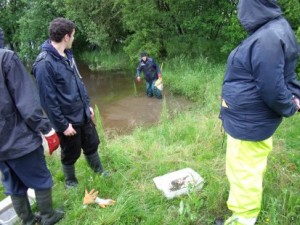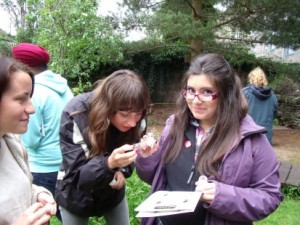
Following on from last week’s soggy bloggy, I’m sorry to say the Glasgow midweek group intrepidly endured another soaking, midgified day on Commonhead Moss on Monday, hacking away at the seeming endless sea of birch saplings that are colonising the bog. On a positive note though, a quick pond-dipping session at the end of the day proved that there is now a breeding colony of newts in a pond where they had not been recorded before.
But what about the bees, I hear you cry? Three delegates from the Glasgow office attended an excellent Bumblebee ID course at the Stirling office on Thursday to learn about the 6 main species of this most cuddly of insects. The course was also attended by 5 interns who are working with TCV this summer on a European exchange scheme. This meant we had representatives from Scotland, Spain, Estonia, Greece, France and Italy in the room, and had the chance to learn some exotic new vocabulary, as well as bumblebee facts.
We learned about the life-cycle of bumblebees, and studied specimens under the microscope, before playing two very competitive rounds of Bumblebee Blockbusters – “I’ll have a red-tailed bumble B, please, Bob!”
You may or may not be astonished to learn that female bumblebees do all the work, and the males mostly just laze about the place, to the extent that this is good way to tell if it’s a male or female bee. Is it buzzing busily from flower to flower, collecting food? It’s a female. Is it hanging about aimlessly in the sun? It’s a guy. Well, how surprising, eh, girls?
The afternoon consisted of a field trip (otherwise known as a walk in the garden) to practise catching and identifying bumblebees, and tick them off on our Bumblebee Bingo cards. Some of the bees got caught time several times in a row, and were very cross about the whole affair, but they still didn’t want to sting us – I said they were cuddly!
For more information about these friendly, helpful pollinators, why there aren’t so many around these days, and how you can help boost their numbers, go here: http://bumblebeeconservation.org/


